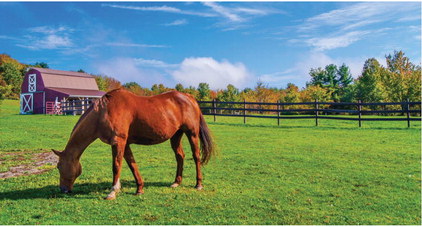Spring Equine Health Preparation Is Essential


With So Many Disease Risks That Can Affect Horses, It Is Challenging To Understand What, When And How Frequently To Vaccinate
Horse owners who don’t travel or attend shows with their horses may wonder if it is important to vaccinate, despite their isolation from other horses. The answer is yes, and it is important to understand what specific diseases to protect horses against as well as proper timing of vaccination. Being in close proximity to horses that travel out of the area is enough to put nontraveling horses at risk. Some geographic regions are known to harbor specific diseases, such as Potomac Horse Fever. West Nile Virus and Western Equine encephalomyelitis are transmitted by vectors (mosquitoes), which puts all equine at risk.
It is important for horse owners to implement practices to minimize animal exposure to disease and prevent its spread. With so many disease risks that can affect horses, it is challenging to understand what, when, and how frequently to vaccinate. Many vaccine combinations are available to target multiple diseases, making it difficult to know which product to purchase.
Core vs. Risk Vaccinations
Vaccinations are categorized based on core versus risk-based diseases. Core vaccinations are those that every horse should receive at least annually, while risk-based vaccines are recommended for horses with particular risk profiles, depending on age, geography, housing, or function. Also, not every horse will be exposed to every disease. Risk-based disease vaccination planning requires the input of a veterinarian familiar with your horses and their use.
Core vaccines are needed against: Eastern and western equine encephalomyelitis: Both are mosquito-borne and sometimes fatal diseases that affect a horse’s nervous system due to inflammation of the brain and spinal cord. Since the risk of exposure and geographic distribution of eastern and western equine encephalomyelitis vary from year to year, all horses are at risk.
West Nile virus: Mosquitoes spread this disease after feeding on infected birds. It is the leading cause of arbovirus encephalitis in horses. The virus has been identified in all of the continental United States, most of Canada and Mexico, and it is fatal in up to 33 percent of horses exhibiting clinical signs of infection. Symptoms in horses include stumbling or poor coordination, depression or apprehension, weak limbs, partial paralysis and muscle twitching.
Tetanus: No matter the location, this life-threatening disease is caused by a soil-borne bacterium. Tetanus is characterized by severe muscle contractions and is often contracted through a wound, most commonly a deep puncture, but can occur whenever a horse experiences a laceration or abrasion. Bacterial contamination of the umbilical cord of a newborn foal is also a common route of tetanus infection.
Rabies: This is an infrequently encountered neurologic disease in horses, and although occurrences are rare, the disease is invariably fatal and poses public health significance. This disease is transmitted by direct contact through the bite of a rabid animal. Common carriers of rabies in the United States include: opossums, skunks, bats, raccoons and foxes. However, any mammal may become infected with, and thus transmit, rabies.
Risk-based vaccines are needed against: Equine herpesvirus (rhinopneumonitis): This common virus occurs in horse populations worldwide but most commonly in weaned foals and yearlings, often in the autumn or winter. The two most common types are equine herpesvirus Type 1, which causes abortion, respiratory disease and neurologic disease, and equine herpesvirus Type 4, which usually causes only respiratory disease but can occasionally cause abortion. EHV is transmitted from horse to horse through contact from fluids and by air transmission.
Equine influenza: This contagious disease of the respiratory tract can spread quickly among groups of horses. The most commonly affected horses are ages one to five, with the main symptom being a dry, hacking cough. Older horses that may have weakened immune systems from frequent exposure at shows or similar events are susceptible, as well. Equine influenza virus symptoms include fever, malaise and upper respiratory symptoms, such as nasal discharge. Flu can make the horse vulnerable to opportunistic pathogens that can cause pneumonia.
Strangles: Caused by the bacterium Streptococcus equi, this highly contagious disease (also known as distemper) commonly affects young horses, but can affect horses of any age. Strangles is typically characterized by high fever, profuse nasal discharge and abscessed lymph nodes (usually under the jaw). S. equi can also cause internal abscesses — in the lungs, liver or lymph nodes in the abdomen and is commonly called “bastard strangles” and can be life threatening and difficult to treat. S. equi can also lurk in the guttural pouches of the horse, causing an apparently symptom-free horse to be a carrier. Strangles is passed through direct contact with nasal secretions or abscess fluid from an infected horse, through aerosolization and through objects such as brushes or hands that have contacted infected materials. Recent studies recommend testing horses for immunity levels before giving Strangles vaccine.
Equine viral arteritis: EVA is primarily a reproductive concern, as it can cause abortion in pregnant mares, death in young foals and a permanent carrier state in stallions. Although many exposed horses will develop no disease signs, when clinical disease does develop, it manifests through: fever, swelling (legs, sheath, scrotum, udder and around eyes), loss of appetite, depression, conjunctivitis, nasal discharge, rash, abortion in mares, pneumonia/ death in foals and short-term sub-fertility in stallions. EVA is passed by direct horse-to-horse contact but can be transferred through indirect means such as shared equipment and handlers.
Just as with people, horses may have a wide range of reactions after receiving vaccinations. The majority of equine vaccines are administered by intramuscular injections, or “shots into the muscle,” on the side of the neck. Some equine vaccines are administered intranasally via a fluid or mist shot up the nose. These don’t cause muscle soreness, but they can induce a fever or make the horse feel a little depressed. Therefore, a day or two of rest after the vaccination may be warranted.
Another way to minimize reactions to vaccines is to avoid major change in the first few days post-vaccination. For example, refrain from increasing the horse’s workload, don’t exercise the horse if it is excessively hot or cold, don’t implement a new exercise program, and avoid changing their feed.
Understanding these diseases and learning about different vaccine combinations can help to make educated decisions about horse health. Providing essential vaccinations for a horse, when administered at the right frequency and time, can help provide optimal immunity against disease.
Preventative and emergency health care costs account for about 16 percent of the total annual cost to maintain a horse. Preventative health care represents six percent of that, and only two percent of the total cost is for core vaccinations. A horse owner might save about two percent of the annual cost by not inoculating the horse with the core vaccines; however, the cost of not vaccinating can far outweigh the potential savings.


